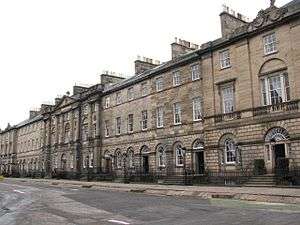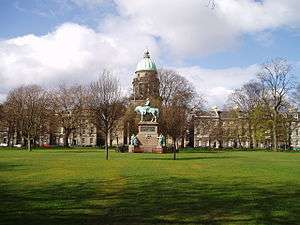Charlotte Square
Charlotte Square is a garden square in Edinburgh, Scotland, part of the New Town, designated a UNESCO World Heritage Site. The square is located at the west end of George Street and was intended to mirror St. Andrew Square in the east. The gardens are private and not publicly accessible.


History
Initially named St. George's Square in James Craig's original plan, it was renamed in 1786 after King George III's Queen and first daughter, to avoid confusion with George Square to the south of the Old Town. Charlotte Square was the last part of the initial phase of the New Town to be "completed" in 1820 (note- the north-west section at Glenfinlas Street was not completed until 1990 due to a long-running boundary dispute). Much of it was to the 1791 design of Robert Adam, who died in 1792, just as building began.
In 1939 a very sizable air-raid shelter was created under the south side of the gardens, accessed from the street to the south.
In 2013 the south side was redeveloped in an award-winning scheme by Paul Quinn, creating major new office floorspace behind a restored series of townhouses.
Edinburgh Collegiate School was located in Charlotte Square.[1]
Gardens
The garden was originally laid out as a level circular form by William Weir in 1808.[2]
In 1861 a plan was drawn up by Robert Matheson, Clerk of Works for Scotland for a larger, more square garden, centred upon a memorial to the recently deceased Prince Albert, the consort of Queen Victoria.
The commission for the sculpture was granted in 1865 to Sir John Steell. The main statue features an equestrian statue of the prince, in field marshal's uniform, dwarfing the four figures around the base. It was unveiled by Queen Victoria herself in 1876.[3] The stone plinth was designed by the architect David Bryce and the four corner figures are by David Watson Stevenson (Science and Learning/Labour), George Clark Stanton (Army and Navy) and William Brodie (Nobility).[4] The statue was originally intended to go in the centre of the eastern edge of the garden, facing down George Street.[5]
This remodelling featured major new tree-planting which took many years to re-establish.
The central open space is a private garden, available to owners of the surrounding properties. For the last three weeks in August each year Charlotte Square gardens are the site of the Edinburgh International Book Festival.
The railings around the gardens were removed in 1940 as part of the war effort. The current railings date from 1947.
Buildings
On the north side, No. 5 was the home of John Crichton-Stuart, 4th Marquess of Bute (1881–1947), who bought it in 1903 and gave it to the National Trust for Scotland on his death. It was the Trust headquarters from 1949 to 2000. Bute did much to promote the preservation of the Square.

Nos. 6 and 7 are also owned by the National Trust for Scotland. No.6, Bute House is the official residence of the First Minister of Scotland. In 1806 it was home to Sir John Sinclair creator of the first Statistical Account of Scotland. No. 7 was internally restored by the Trust in 1975 to its original state, and is open to the public as The Georgian House.[6] The upper floor was formerly the official residence of the Moderator of the General Assembly of the Church of Scotland. The building includes one fireplace brought from Hill of Tarvit in Fife in 1975.
West Register House, formerly St. George's Church, forms the centre of the west side. It was designed by the architect Robert Reid in 1811, broadly to Adam's plan. The church opened in 1814 and was converted to its current use in 1964. It is one of the main buildings of the National Records of Scotland
Residents
From the very inception of Charlotte Square in 1791, it was anticipated it would be one of the top addresses in Edinburgh.[7] As the Victorian era commenced, the square was increasingly occupied by the elite of the middle class: legal and medical professionals. This is reflected in the notable residents listed below. As the 20th century began most buildings were still occupied as residential addresses, although more are offices, solely occupied by guardians.[8]
| Side | Number | Resident |
|---|---|---|
| North | 4 | Sir Alexander Hugh Freeland Barbour lived at no.4 (previously occupied by Rev Dr David Aitken FRSE) |
| 4 | "Rev Dr David Aitken" FRSE | |
| 5 | Sir James Fergusson, 4th baronet (1765-1838) lived at no.5[9] | |
| 5 | Robert Nasmyth FRSE, dentist to Queen Victoria (1792-1870) | |
| 6, Bute House | Sir Mitchell Mitchell-Thomson, 1st Baronet[10] | |
| 7, The Georgian House | Charles Neaves, Lord Neaves | |
| Rev Alexander Whyte, Minister of St. George's West Free Church in Shandwick Place was resident in 1901[11] | ||
| 8 | Thomas R Ronaldson, General Practitioner, was resident in 1901, together with his son Thomas Martine Ronaldson, artist | |
| 9 | Patrick Robertson, Lord Robertson[12] | |
| James Syme, Surgeon | ||
| Joseph Lister, Son-in-law of James Syme | ||
| Sir Douglas Archibald Seton-Steuart, 5th and final Seton-Steuart baronet was resident in 1901 | ||
| 10 | James Begbie, Surgeon | |
| 11 | Aeneas MacBean WS | |
| West | 12 | James Joseph Hope-Vere[13] Member of Parliament for Linlithgowshire, 1743-68[14] |
| James Morton Robertson wine Merchant was resident in 1901 | ||
| 13 | Sir William Fettes, Scottish Businessman whose bequest led to the foundation of Fettes College | |
| Francis Mitchell Caird, President of the Royal College of Surgeons, Edinburgh[15] | ||
| 14 | Lord Cockburn, Whig lawyer, historian and conservationist and afterwards Georbge Moir | |
| 15 | Charles Alfred Cooper, editor of The Scotsman | |
| 16 | Patrick Heron Watson, surgeon and pioneer of anaesthetic development and modern dentistry was resident in 1901 | |
| 17 | Viscount Haldane was born at No.17. | |
| 17 | James Wolfe Murray, Lord Cringletie in the 1830s | |
| 19 | Lord Torphichen | |
| Thomas Grainger Stewart, president of the Royal College of Physicians. His widow was present in 1901. | ||
| 20 | Prof John Batty Tuke then John Clarence Webster | |
| 22 | James Ritchie | |
| South | 24 | The birthplace of Field Marshal Earl Haig |
| 25 | Adam Duff, Sheriff of Midlothian[16] | |
| Sir John Halliday Croom FRSE[17] | ||
| 26 | Prof John Chiene, Professor of Surgery at Edinburgh University | |
| 27 | Sir Alexander Gibson-Maitland of Cliftonhall | |
| 28 | David Boyle, Lord Boyle | |
| 29 | Dr David Berry Hart | |
| 30 | Dr James Matthews Duncan then Prof William Rutherford Sanders | |
| 31 | William Adam of Blair Adam then Thomas Annandale | |
| East | 33 | Sir Alexander C Gibson-Maitland of Clifton Hall[18] |
| 34 | Archibald Campbell Swinton Professor of Civil Law at Edinburgh University | |
| 35 | William Allan Jamieson President of the Royal College of Physicians of Edinburgh lived and died at 35 | |
| 38 | Sir William Cunningham Dalyell, an officer in the British Royal Navy who served in the French Revolutionary Wars lived at 38 in the 1830s[19] It was then purchased by John Learmonth. | |
| 40 | Home of the Juridical Society[20] | |
| 44 | Robert Reid redesigned no.44 internally, as his own home. | |
| 45 | Sir Robert William Philip, pioneer in the treatment of tuberculosis[21] was resident from 1898 until his death in 1938, but absent in 1901. Prior to this it had been the home of Dr James Macadam Hare FRSE HEICS |
Pioneer of the telephone, Alexander Graham Bell, was born in nearby South Charlotte Street.
References
- Reid, Walter (2011) [2009]. "Chapter 2: Family and youth". Architect of Victory: Douglas Haig (Kindle ed.). Birlinn. ISBN 978-1843410454. Retrieved 9 January 2016.
- Buildings of Scotland: Edinburgh by Gifford, McWilliam and Walker
- Gunnis, Rupert. Dictionary of British Sculptors, 1660-1857
- McWilliam, Colin (1984). Edinburgh. The Buildings of Scotland. Yale.
- Monuments and monumental inscriptions in Scotland: The Grampian Society, 1871
- "Georgian House". National Trust for Scotland.
- "History of Charlotte Square - The Charlotte Square Collection". Charlottesquarecollection.com. Retrieved 7 April 2018.
- "Guides". Scotlandspeople.gov.uk. Retrieved 7 April 2018.
- "Edinburgh Post Office annual directory, 1832-1833". National Library of Scotland. Retrieved 18 January 2018.
- Edinburgh and Leith Post Office Directory 1905-6
- "Alexander Whyte: Lessons to Learn - Banner of Truth". banneroftruth.org. Retrieved 18 January 2018.
- "Edinburgh Post Office annual directory, 1832-1833". National Library of Scotland. Retrieved 18 January 2018.
- "Edinburgh Post Office annual directory, 1832-1833". National Library of Scotland. Retrieved 18 January 2018.
- "HOPE VERE, James Joseph (1785-1843), of Craigie Hall, Linlithgow and Blackwood, Lanark | History of Parliament Online". www.historyofparliamentonline.org. Retrieved 18 January 2018.
- "History of the Chair of Clinical Surgery" (PDF). Ed.ac.uk. Retrieved 7 April 2018.
- "Edinburgh Post Office annual directory,1832-1833". National Library of Scotland. Retrieved 18 January 2018.
- Edinburgh and Leith Post Office directory 1901-2
- "Edinburgh Post Office annual directory, 1832-1833". National Library of Scotland. Retrieved 18 January 2018.
- "Edinburgh Post Office annual directory, 1832-1833". National Library of Scotland. Retrieved 18 January 2018.
- "Edinburgh Post Office annual directory, 1832-1833". National Library of Scotland. Retrieved 18 January 2018.
- "Robert William Philip stone plaque". openplaques.org. Retrieved 18 January 2018.
| Wikimedia Commons has media related to Charlotte Square. |